Thailand is a noodle paradise
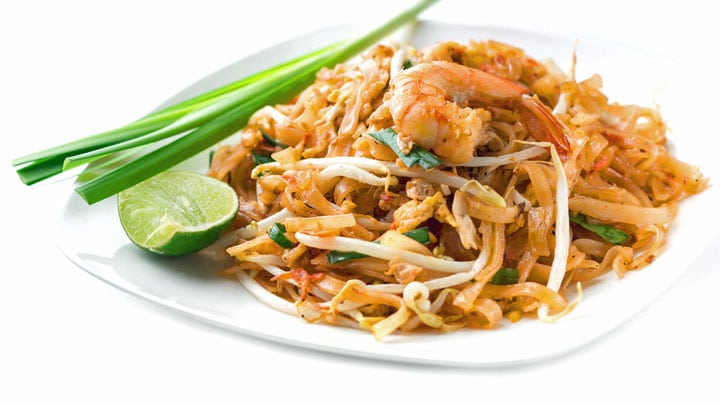
pad Thai
If we are to believe Wikipedia – and who wouldn't? – his noodles “…foods made from unleavened dough and cooked in water,” which, according to the same infallible encyclopedic source, “traditionally one of the staple foods in many Asian countries “. I couldn't have phrased it better were it not for the fact that this definition does a gross injustice to the delicious noodle paradise that is Thailand.
It is sometimes said that a man's love goes through the stomach and I can only confirm this when it comes to my relationship with my Thai spouse. She doesn't just make the best Som Tam (papaya salad) in the world, but also knows how to conjure up the tastiest noodle preparations in no time.
I can now, in all modesty, call myself a noodle aficionado and connoisseur and that is why I would like to take you on a sensuous trip through Noodleland today, and I am not talking about the ingredients that are present in every Thai home. Mama or instant noodles, but about some of the most popular noodle preparations in Thai cuisine. Let me start right away with the absolute classic of classics: pad Thai. I must clear up two widespread misconceptions right off the bat: pad Thai may not be Thai at all in origin, but would have been inspired by Pho Sao, a Vietnamese rice noodle recipe believed to have been introduced to Siam by Vietnamese merchants in the heyday of the Ayutthaya principality. And secondly, this noodle preparation is a lot less classic than expected.
After all, the current recipe dates from 1940. Thailand was then on the eve of the Second World War and Marshal Plaek Phibulsongkram, the autocratic prime minister of the country, wanted to boost nationalism by creating a 'national' dish. The underlying thought behind the creation of this pad Thai was purely economic. Due to the threat of war, Thai rice exports had fallen drastically and the prime minister wanted to get rid of the rice stocks. As a result, the traditional – Chinese – egg noodles were replaced by wide, soaked rice noodles that are stir-fried at high temperature together with tofu, eggs and shrimps in a mix of tangy tamarind paste and salty fish sauce with some palm sugar, hot chili peppers, finely chopped spring onions, shallot segments and Chinese chives. This quick to prepare and especially super simple dish is finished with fresh lime, coriander and coarsely chopped roasted peanuts. It is not for nothing that this slightly on the palate, sticky taste concentration invariably figures in the top of the best dishes from the world cuisine.
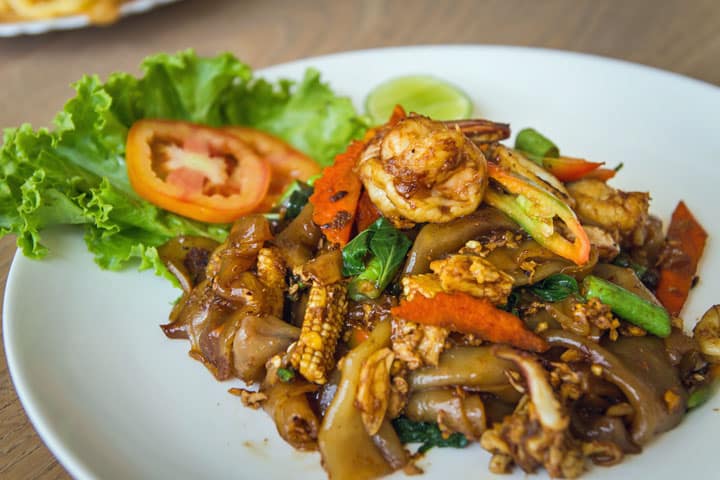
Pad see ew
Pad see ew, stir-fried noodles in soy sauce, is the traditional counterpart of Pad Thai. Where this last preparation can rather be qualified as sweet is Pad see ew a very balanced dish in terms of taste that, through the use of vinegar, soy and oyster sauce, gets a clear and very attractive sweet-salt accentuation. By caramelizing these ingredients, this preparation also gets a slightly smoked barbecue touch. The core of this preparation is formed by Sen Yai, wide and wafer-thin fresh rice noodles that are fried with Kai Lan, Chinese broccoli and – preferably – diced chicken fillet. Honestly? Delicious…!
A similar dish to Pad See Ew Toad Kee Mauw or Drunk Noodles. This preparation owes its somewhat bizarre name to the fact that its consumption can perfectly coincide with consuming an ice-cold beer or dealing with a hangover. Claimed qualities that I can only confirm from my own experience (5555). Here, too, wide, thin rice noodles and chicken or scampi form the core of the meal, which is enriched with ingredients such as long beans, baby corn and chili peppers. The big difference lies in the use of the spicy and pronounced taste of the generously added and briefly baked Thai basil.
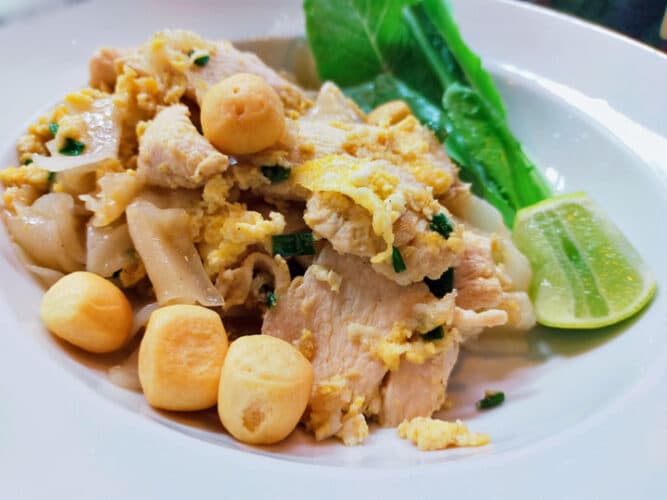
Kuay Teow Kua Kai
Another captivating chicken noodle preparation is Kuay Teow Kai or sweet chicken noodles. A simple but oh so tasty brown noodle soup that is richly provided with large pieces of chicken and, for those who like it, of course also the obligatory chicken legs on which most Thais can suck for hours... Shi-take or other mushrooms and eggs are often added to this.
JW von Goethe already knew it more than 200 years ago: “In der Beschränkung zegt sich erst der Meister”. This statement applies in full to the traditional one Boat Noodles. This savory, dark brown noodle soup with meatballs has been cooked since time immemorial in the sloops on the Chao Phraya and served in tiny bowls. The choice for this mini format was obvious, given the very limited storage and cooking space and the fact that the cook in question also had to steer his/her sloop at the same time. However, this dish is not for everyone farang because the lavish use of pig's or beef's blood mixed with soy sauce gives this dish a distinct metallic taste that is not appreciated by everyone.
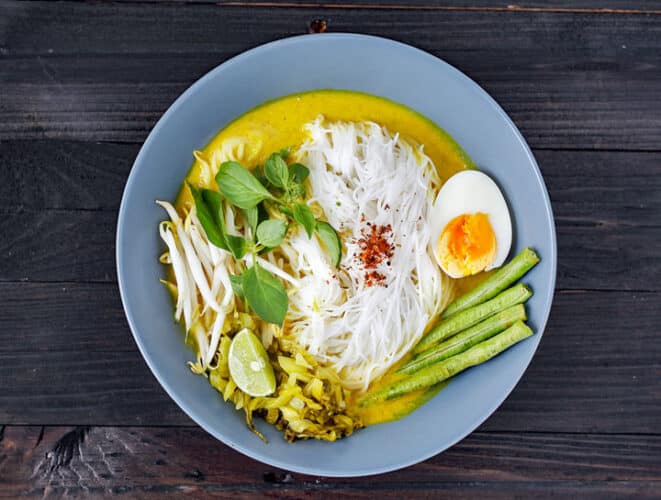
Kanom jeen nam ya
Khanom jeen or rice noodles can be found in Thailand in all shapes and sizes. One of the most popular and possibly tastiest preparations is Khanom Jeen Nam Ya or fish curry with rice vermicelli. This slightly spicy and orange-coloured curry preparation with pieces of cooked fish is a concentrated flavor bomb that is further enriched by the addition of coconut milk. Aroy mak mak…. Even better, but that's a personal opinion, I think Kung ob Wunsen or glass noodles with king prawns. Another taste sensation that you will not soon forget.
Lovers of Barbie pink will undoubtedly get their money's worth with Yentafo or sweet, rosy noodles. Don't be put off by the candy color. If you're looking for a noodle soup that's fresh and sweet at the same time, this is the one for you. And if you're not too tender, you can always spice them up with a few good spoonfuls of dried chilli flakes… Another maverick is Rad Na or noodles, usually rice vermicelli but crispy egg noodles can also be used perfectly, which are topped with a fatty gravy and finished with the pork and vegetables cooked in the gravy.
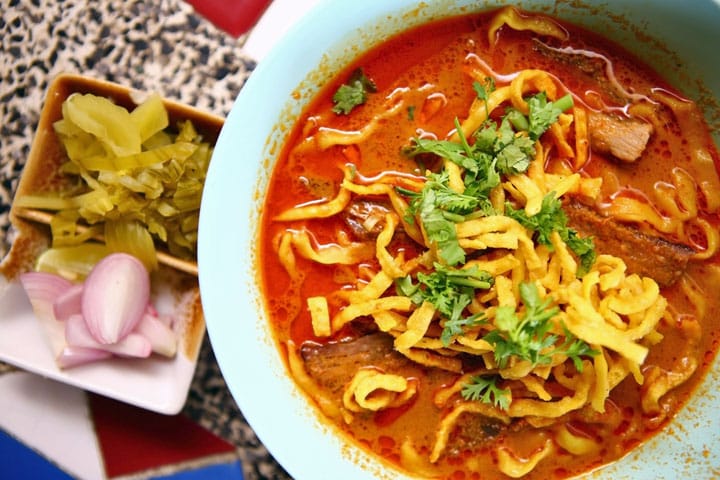
Khao soi
I finish with my all time favorite: Khao Soi, the noodle specialty of Northern Thailand. This richly spiced yellow curry clearly bears the stamp of southern Chinese Yunan cuisine and was popular not only in the ancient kingdom of Lanna, but also in Laos and Burma. Khao soi caused by the well-thought-out balance of coconut milk, chili and lime an umami taste explosion that cannot leave anyone untouched. The crispy, crunchy egg noodles crown this unique dish that can become addictive. Don't say I didn't warn you…!
Never forget that you can always flavor the served noodle soup according to your own devotion and ability with the seasonings that are invariably on the table, such as chili powder, Nam pla (fish sauce), sugar, rice vinegar and Took Prik (chili's in fish sauce). Though I guess neophytes and farang with a sensitive taste palette so as not to eat large portions right away Took Prik to get started…


I am not a connoisseur, but I am a great lover of noodle dishes.
Very nice article! I am a fan of noodles and will be going to Thailand for over a month early next year, can't wait to try all these noodle variants 🙂